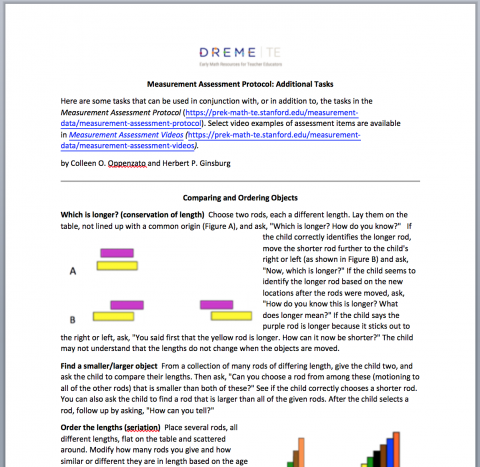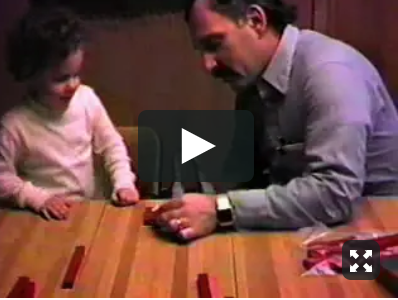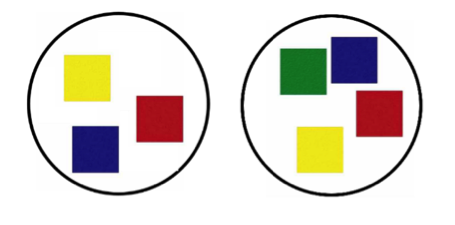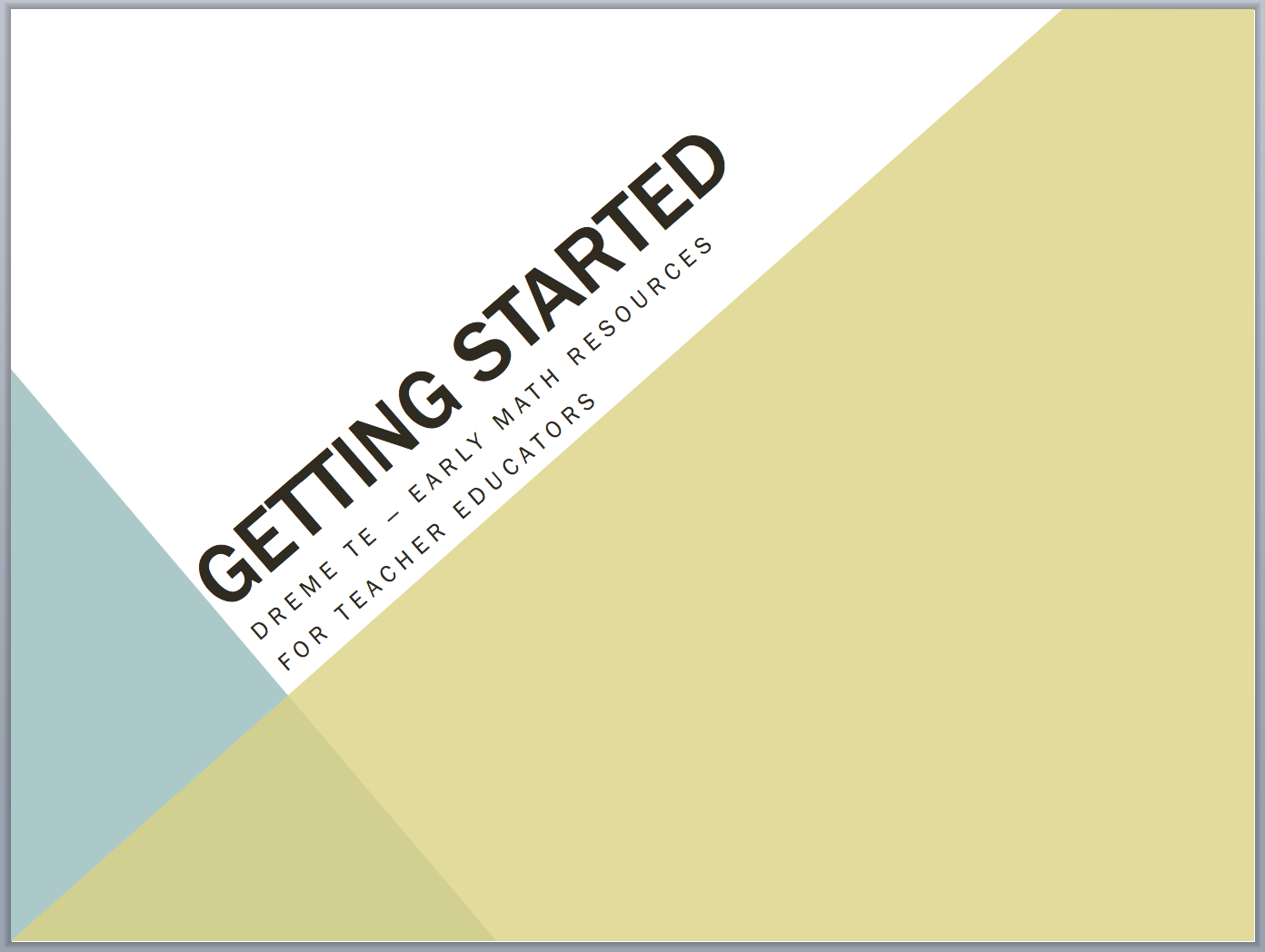These tasks are designed to help you use the clinical interview to assess an individual child’s understanding of measurement. The protocol begins with relatively simple measurement tasks that rely on perception and advances to more complex tasks requiring measuring in units, although you can pick and choose among them. They do not need to be given in order.
Revised March 30, 2019
The tasks in this protocol can help you answer these big ideas about a child’s understanding of measurement:
- Differences in size can be perceived and described intuitively.
- Objects can be compared and ordered.
- Non-standard and standard units can be used to measure.
The resource Math Thinking Conversations provides guidelines for how to use these kinds of tasks to explore a child’s mathematical understanding.
The tasks that follow have been organized according to the questions listed above. For more assessment tasks that can be used in conjunction with, or in addition to, the tasks below, see Measurement Assessment Protocol: Additional Tasks (download below). Select video examples of assessment items are available in Measurement Assessment Videos.
Perceiving and Describing Differences in Size
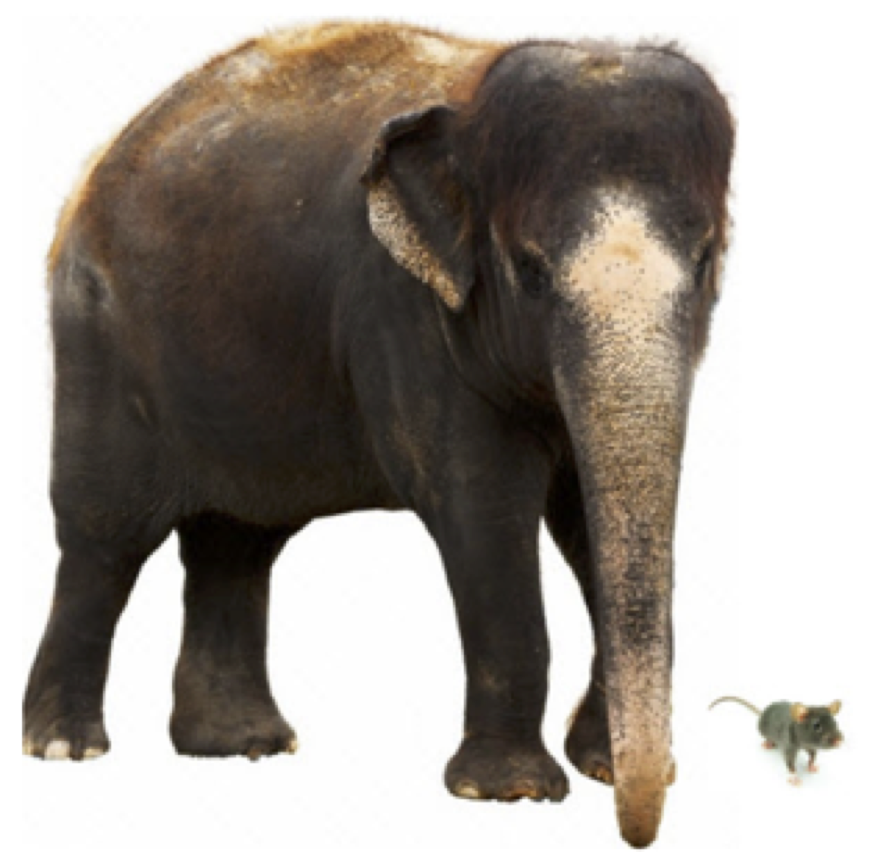 General measurement questions Start the discussion by asking general questions like these:
General measurement questions Start the discussion by asking general questions like these:
"What is something, anything in the world, that is big?"
"What is something that is small?"- Questions using photos Show pictures of familiar objects or animals that are different sizes. For example, show a picture of an elephant. Ask, "What is this? Is it big or small?" Then do the same with a picture of a mouse, preferably one with a very long tail so there are multiple dimensions to consider.
- Follow-up questions (determine which attributes are considered) Ask follow-up questions about the objects or animals the child identified as big or small. For example ask, "How is this big (small)?" Try to determine what attributes the child is considering. Is the child considering length, height, or width or other attributes like weight or volume? See which words, if any, the child uses to describe how objects are big or small. If you notice a child is having difficulty verbalizing, ask the child, "Can you show me with your hands?" Follow up to see if the child will consider other attributes, too. For example, if a child says an elephant is big and spreads hands wide, use your hands to show tall and ask, "Is it also big like this?" Watch Robbie: Big & Small here.
Comparing and Ordering Objects
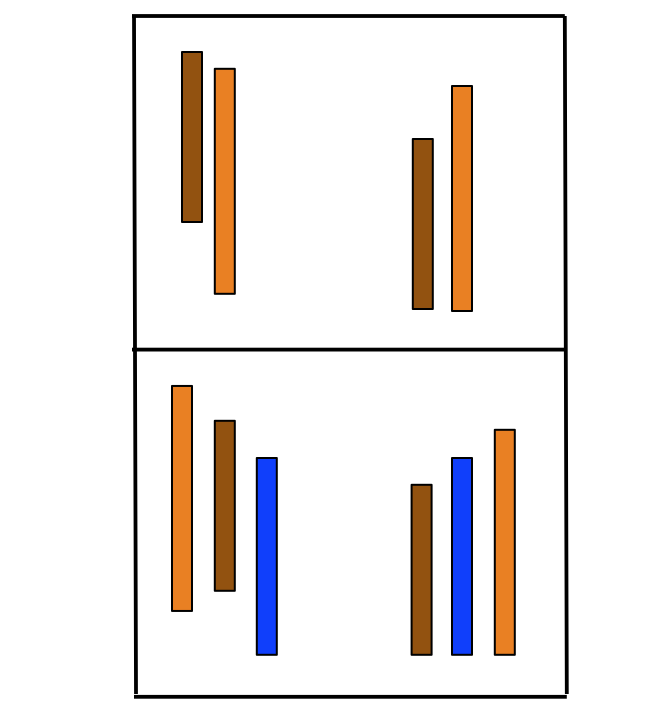 Length is very salient for young children. The following tasks all focus on that attribute.
Length is very salient for young children. The following tasks all focus on that attribute.
- Which of two objects is longer? Provide the child with two sticks or rods, one which is clearly longer than the other. Place them so they are lying flat on the table but do not have a common origin (as shown in the picture on the left). Ask, "Which is longer? How do you know?" The child may place the objects side by side, lining them up along a common baseline or stand them up vertically. If the child does not accurately identify the longer object, try two other sticks or rods that are even more different in size. Watch Bella: Compare Lengths here.
- Order three objects If the child successfully compared two objects of different length, ask the child to order three objects of different length from shortest to longest. If the child has used terms like small, big, and bigger in earlier tasks, you can use these words to introduce the three objects task. Later you can explain that short, longer, and longest are more accurate words. The child may line up the objects along a common baseline (lying flat on the table) or stand them up vertically to prove they are ordered correctly, or may not move them at all.
Measuring Using Non-Standard Units
- Introduction to measurement using non-standard units Show how two cubes can be connected and placed next to a rod that is about three cubes long. Ask, "Is that enough? Is this two cubes long?" See if the child can recognize that three cubes would be a good approximation of the rod's length. Allow the child to explore. For example, if the child wants to see if four cubes would be a better measure, let him try it to show that it isn't.
 Quantify length using non-standard units Choose an object that has a whole number length if measured using connecting cubes. Provide the object for the child to measure, asking, "How many cubes long is this object?” As the child measures, take note of whether the child connects the cubes, lines them up properly, with a common starting point, and is able to describe the length using the number of cubes. For example, does the child connect the cubes and measure the orange stick as six cubes long, or does the child only line up five cubes? If the child is only off by one cube, you can continue to have the child measure or you can challenge the child by asking, "Are you sure this is five cubes long or do we need some more?" Watch Alice: Non-standard units here.
Quantify length using non-standard units Choose an object that has a whole number length if measured using connecting cubes. Provide the object for the child to measure, asking, "How many cubes long is this object?” As the child measures, take note of whether the child connects the cubes, lines them up properly, with a common starting point, and is able to describe the length using the number of cubes. For example, does the child connect the cubes and measure the orange stick as six cubes long, or does the child only line up five cubes? If the child is only off by one cube, you can continue to have the child measure or you can challenge the child by asking, "Are you sure this is five cubes long or do we need some more?" Watch Alice: Non-standard units here.
Measuring with Inches and Centimeters
- Introducing the ruler Show the child a ruler and ask if the child has used one before. If not, indicate an inch on the ruler. Then point to randomly selected numerals on the ruler and ask, "What is this number?" to make sure the child can read the numbers before measuring.
- Quantify length using a ruler Choose an object that has a whole number length in inches. Ask the child to use the ruler to measure the object. As the child measures, take note of whether the child lines up the ruler correctly, starting to measure at the origin (the zero mark), and if the child correctly reads the length on the other side. You can also include some objects that do not have whole number lengths to see how the child describes them. For example, does the child say, "This is a little bit longer than one" or "This is between two and three." Watch Sebastian: Standard Units here.
Sarama, J., & Clements, D. H. (2009). Early childhood mathematics education research: Learning trajectories for young children. New York: Routledge.

